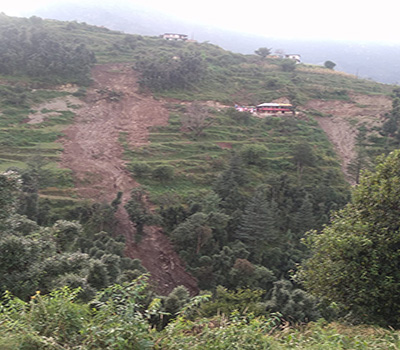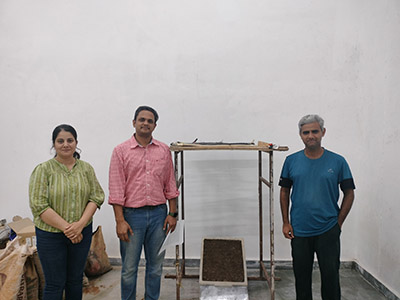MANDI: IIT Mandi researchers revolutionize soil erosion control using bioengineering. Their findings, featured in the Journal of Soil and Sediments, unveil a game-changing approach.
Soil erosion impacts soil, crops, and water systems, causing instability and landslides. Bioengineering with plant roots stabilizes soil, maintains biodiversity.
This research has come as a glimmer of hope for the Mountain states which face a massive crisis of soil erosion mainly during the rainy season.
Much, however, depend how this research is taken by the stakeholders and government agencies from the Labs to the Land.
IIT Mandi gauges bioengineering effectiveness using innovative methods.
Led by Dr. Kala Venkata Uday and Dr. Arnav Bhavsar Vinayak, along with research scholars Ms. Charu Chauhan and Mr. Manvendra Singh, the study marks a pivotal advancement in environmental conservation.
Soil erosion, a pressing global concern, wreaks havoc on soil quality, agricultural productivity, and water systems, while triggering hazardous landslides on unstable slopes. ī
ī
The IIT Mandi team has harnessed the power of plant roots and fibers to counteract this menace. By anchoring the soil and preserving biodiversity, these bioengineering solutions offer a lifeline to eroded landscapes.
Astonishingly, the Food and Agriculture Organization's Global Soil Partnership has reported an alarming annual loss of 75 billion tonnes of soil worldwide, resulting in an estimated staggering financial toll of US$400 billion each year.
In India, a dire scenario prevails, with 60% of land grappling with soil erosion.
Urgent action is required to salvage about 145 million hectares out of the country's total land area of 305.9 million hectares.
The repercussions of soil erosion encompass fertility loss, reduced water retention capacity, diminished crop yields, escalated runoff, and environmental degradation due to sediment buildup in water bodies. Furthermore, soil erosion renders landscapes susceptible to dangerous landslides, particularly on steep inclines.
Harnessing the well-established principle that plant roots play a pivotal role in reducing soil erosion by enhancing soil quality and curbing runoff, the IIT Mandi researchers have extended the application of bioengineering techniques.
By weaving native plant species and fibers into the environment, the team has concocted innovative strategies to evaluate the effectiveness of these solutions in combating erosion.
Setting up an economical laboratory simulation of rainfall-induced erosion, the researchers have enabled precise examination of factors such as rainfall intensity, slope gradient, soil texture, and vegetation cover.
Employing sophisticated image analysis, they have quantified soil erosion and showcased the resounding success of bioengineering interventions in preventing erosion. Their study delves into the mechanics of soil detachment, transport, and deposition.
Dr. Arnav Bhavsar Vinayak noted, "Image analysis has proven its mettle in assessing limited areas like embankments, slopes, and short stretches.
However, for larger expanses, the implementation of unmanned aerial vehicles (UAVs) and remote-sensing imaging is more effective. Our approach, employing contour detection and filling, surpasses complex and costly existing techniques."
The study's findings reveal that a synergistic collaboration between natural vegetation roots and introduced fibers can significantly bolster soil cohesion.
Erosion rates are influenced by soil type, moisture content, and reinforcement materials, offering valuable insights for soil conservation strategies.
This multidisciplinary approach, uniting bioengineering and image analysis, charts an optimistic course toward combatting the scourge of soil erosion.
The researchers have successfully demonstrated the transformative potential of native vegetation and Indian goose grass fibers in converting erosion-prone zones into virtually erosion-free landscapes. The study emphasizes the importance of tailoring the choice and quantity of materials—be it fibers or plants—to the specific type and form of erosion.
This research paves the way for more effective erosion control methodologies, embracing the use of natural resources.
Dr. K. V. Uday highlighted the practical implications and future prospects of their work, stating, "We've devised a straightforward technique to assess the efficiency of nature-based erosion mitigation solutions.
"Our approach uniquely discerns between splash-induced and runoff-induced erosion—a capability absent in current methodologies. Numerical studies further enhance targeted strategies for curbing soil erosion across expansive fields."







